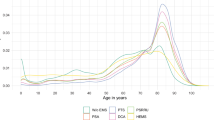Abstract
Purpose
Pre-hospital trauma life support (PHTLS®) includes a standardized algorithm for pre-hospital care. Implementation of PHTLS® led to improved outcome in less developed medical trauma systems. We aimed to determine the impact of PHTLS® on quality of pre-hospital care in a European metropolitan area. We hypothesized that the introduction of PHTLS® was associated with improved efficiency of pre-hospital care for severely injured patients and less emergency physician deployment.
Methods
We included adult polytrauma (ISS > 15) patients that were admitted to our level one trauma center during a 7-year time period. Patients were grouped based on the presence or absence of a PHTLS®-trained paramedic in the pre-hospital trauma team. Group I (no-PHTLS group) included all casualties treated by no-PHTLS®-trained personnel. Group II (PHTLS group) was composed of casualties managed by a PHTLS® qualified team. We compared outcome between groups.
Results
During the study period, 187,839 rescue operations were executed and 280 patients were included. No differences were seen in patient characteristics, trauma severity or geographical distances between groups. Transfer times were significantly reduced in PHTLS® teams than non-qualified teams (9.3 vs. 10.5 min, P = 0.006). Furthermore, the in-field operation times were significantly reduced in PHTLS® qualified teams (36.2 vs. 42.6 min, P = 0.003). Emergency physician involvement did not differ between groups.
Conclusion
This is the first study to show that the implementation of PHTLS® algorithms in a European metropolitan area is associated with improved efficiency of pre-hospital care for the severely injured. We therefore recommend considering the introduction of PHTLS® in metropolitan areas in the first world.

Similar content being viewed by others
References
Häske D, Stuke L, Bernhard M, et al. Comparison of the prehospital trauma life support recommendations and the German national guideline on treatment of patients with severe multiple injuries. J Trauma. 2006;81(2):388–93.
Wölf CG, Wentzensen A, Gliwitzky B. Standardisierte Primärtherapie des polytraumatisierten Patienten Prehospital Trauma Life Support® und Advanced Trauma Life Support®. Der Unfallchirurg. 2009;10:848–53.
NAEMT In: PHTLS: Prehospital Trauma Life Support. 8th ed. Burlington, MA: Jones & Bartlett Learning; 2016.
Ali J, Adam RU, Gana TJ, et al. Effect of the prehospital trauma life support program (PHTLS) on prehospital trauma care. J Trauma. 1997;42:786–90.
Häske D, Beckers SK, Hofmann M, et al. Subjective safety and self-confidence in pre-hospital trauma care and learning progress after trauma-courses: part oft he prospective longitudinal mixed-methods EPPTC-trail. Scand J Trauma Resc Emerg Med. 2017;25:79.
Blomberg H, Svennblad B, Michaelsson K, et al. Prehospital trauma life support training of ambulance caregivers and the outcomes of traffic-injury victims in Sweden. J Am Coll Surg. 2013;217:1010–9.
Johansson J, Blomberg H, Svennblad B, et al. Prehospital Trauma Life Support (PHTLS) training of ambulance caregivers and impact on survival of trauma victims. Resuscitation. 2012;83:1259–64.
Wrobel F, Lenz M. Präklinisches traumamanagement. Notfall Rettungsmed. 2012;15:247–54.
Polytrauma Guidelines Update Group. Level 3 guideline on treatment of patients with severe and multiple injuries. Eur J Trauma. 2018;44(S1):3–271.
Copes WS, Champion HR, Sacco WJ, et al. The injury severity score revised. J Trauma. 1988;28(1):69–77.
Raatiniemi L, Mikkelsen K, Fredriksen K, et al. Do pre-hospital anaesthesiologists reliably predict mortality using the NACA severity score? A retrospective cohort study. Acta Anaesthesiol Scand. 2013;57(10):1253–9.
Weiss M, Bernoulli L, Zollinger A. The NACA scale. Construct and predictive validity of the NACA scale for prehospital severity rating in trauma patients. Anaesthesist. 2001;50(3):150–4.
Ali J, Adam RU, Gana TJ, George B, et al. Impact of the prehospital trauma life support programme in Trinidad and Tobago. West Indian Med J. 1998;47(3):102–4.
Salomone JP, Pons PT, McSwain NE. PHTLS Prehospital trauma life support. Military. 7th ed. St. Louis: Mosby JEMS Elsevier; 2011.
Gries A, Zink W, Bernhard M, Messelken M, Schlechtriemen T. Einsatzrealität im Notarztdienst. Notfall + Rettungsmedizin. 2005;8:391–8.
Moorthy K, Munz Y, Dosis A, et al. The effect of stress-inducing conditions on the performance of a laparoscopic task. Surg Endosc. 2003;17(9):1481–4.
Müller MP, Hänsel M, Fichtner A. Excellence in performance and stress reduction during two different full scale simulator training courses: a pilot study. Resuscitation. 2009;80(8):919–24.
Günkel S, König M, Albrecht R. Deployment and efficacy of ground versus helicopter emergency service for severely injured patients. Analysis of a nationwide Swiss trauma center. Unfallchirurg. 2015;118(3):233–9.
Author information
Authors and Affiliations
Corresponding author
Ethics declarations
Conflict of interest
The authors declare that they have no conflict of interest.
Rights and permissions
About this article
Cite this article
Teuben, M., Löhr, N., Jensen, K.O. et al. Improved pre-hospital care efficiency due to the implementation of pre-hospital trauma life support (PHTLS®) algorithms. Eur J Trauma Emerg Surg 46, 1321–1325 (2020). https://doi.org/10.1007/s00068-019-01141-1
Received:
Accepted:
Published:
Issue Date:
DOI: https://doi.org/10.1007/s00068-019-01141-1




